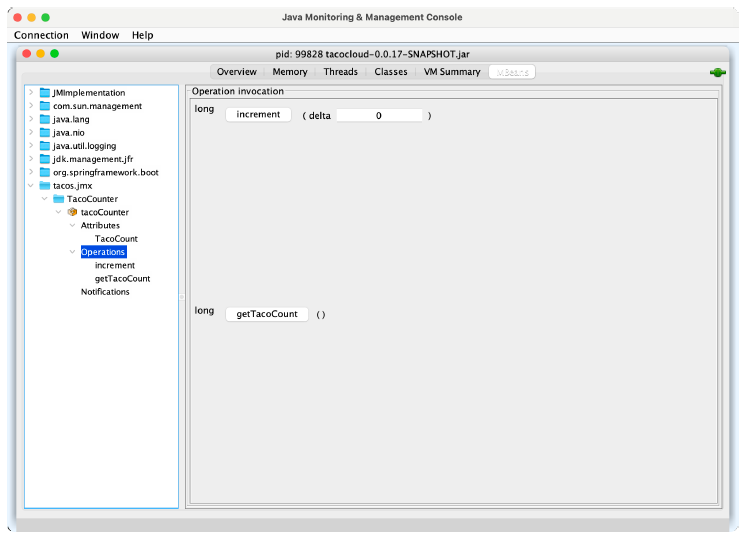17.2 Creating your own MBeans
Spring makes it easy to expose any bean you want as a JMX MBean. All you must do is annotate the bean class with @ManagedResource and then annotate any methods or properties with @ManagedOperation or @ManagedAttribute. Spring will take care of the rest.
For example, suppose you want to provide an MBean that tracks how many tacos have been ordered through Taco Cloud. You can define a service bean that keeps a running count of how many tacos have been created. The following listing shows what such a service might look like.
Figure 17.1 Actuator endpoints are automatically exposed as JMX MBeans
package tacos.jmx;
import java.util.concurrent.atomic.AtomicLong;
import org.springframework.data.rest.core.event.AbstractRepositoryEventListener;
import org.springframework.jmx.export.annotation.ManagedAttribute;
import org.springframework.jmx.export.annotation.ManagedOperation;
import org.springframework.jmx.export.annotation.ManagedResource;
import org.springframework.stereotype.Service;
import tacos.Taco;
import tacos.data.TacoRepository;
@Service
@ManagedResource
public class TacoCounter
extends AbstractRepositoryEventListener<Taco> {
private AtomicLong counter;
public TacoCounter(TacoRepository tacoRepo) {
tacoRepo
.count()
.subscribe(initialCount -> {
this.counter = new AtomicLong(initialCount);
});
}
@Override
protected void onAfterCreate(Taco entity) {
counter.incrementAndGet();
}
@ManagedAttribute
public long getTacoCount() {
return counter.get();
}
@ManagedOperation
public long increment(long delta) {
return counter.addAndGet(delta);
}
}The TacoCounter class is annotated with @Service so that it will be picked up by component scanning and an instance will be registered as a bean in the Spring application context. But it’s also annotated with @ManagedResource to indicate that this bean should also be an MBean. As an MBean, it will expose one attribute and one operation. The getTacoCount() method is annotated with @ManagedAttribute so that it will be exposed as an MBean attribute, whereas the increment() method is annotated with @ManagedOperation, exposing it as an MBean operation. Figure 17.4 shows how the TacoCounter MBean appears in JConsole.  Figure 17.4 TacoCounter'S operations and attributes as seen in JConsole
Figure 17.4 TacoCounter'S operations and attributes as seen in JConsole
Working with MBean operations and attributes is largely a pull operation. That is, even if the value of an MBean attribute changes, you won’t know until you view the attribute through a JMX client. Let’s turn the tables and see how you can push notifications from an MBean to a JMX client.
